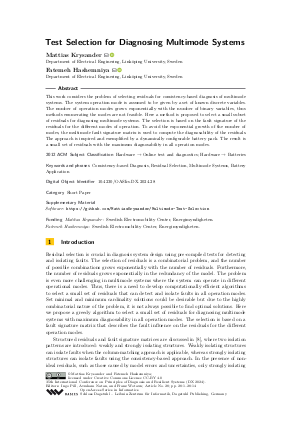Test Selection for Diagnosing Multimode Systems (Short Paper)
Authors
Mattias Krysander  ,
Fatemeh Hashemniya
,
Fatemeh Hashemniya 
-
Part of:
Volume:
35th International Conference on Principles of Diagnosis and Resilient Systems (DX 2024)
Part of: Series: Open Access Series in Informatics (OASIcs)
Part of: Conference: International Conference on Principles of Diagnosis and Resilient Systems (DX) - License:
 Creative Commons Attribution 4.0 International license
Creative Commons Attribution 4.0 International license
- Publication Date: 2024-11-26
File

PDF
OASIcs.DX.2024.28.pdf
- Filesize: 0.75 MB
- 14 pages
Document Identifiers
Subject Classification
ACM Subject Classification
- Hardware → Online test and diagnostics
- Hardware → Batteries
Keywords
- Consistency-based Diagnosis
- Residual Selection
- Multimode Systems
- Battery Application
Metrics
- Access Statistics
-
Total Accesses (updated on a weekly basis)
0PDF Downloads0Metadata Views
Abstract
This work considers the problem of selecting residuals for consistency-based diagnosis of multimode systems. The system operation mode is assumed to be given by a set of known discrete variables. The number of operation modes grows exponentially with the number of binary variables, thus methods enumerating the modes are not feasible. Here a method is proposed to select a small subset of residuals for diagnosing multimode systems. The selection is based on the fault signature of the residuals for the different modes of operation. To avoid the exponential growth of the number of modes, the multimode fault signature matrix is used to compute the diagnosability of the residuals. The approach is inspired and exemplified by a dynamically configurable battery pack. The result is a small set of residuals with the maximum diagnosability in all operation modes.
Cite As Get BibTex
Mattias Krysander and Fatemeh Hashemniya. Test Selection for Diagnosing Multimode Systems (Short Paper). In 35th International Conference on Principles of Diagnosis and Resilient Systems (DX 2024). Open Access Series in Informatics (OASIcs), Volume 125, pp. 28:1-28:14, Schloss Dagstuhl – Leibniz-Zentrum für Informatik (2024)
https://doi.org/10.4230/OASIcs.DX.2024.28
BibTex
@InProceedings{krysander_et_al:OASIcs.DX.2024.28,
author = {Krysander, Mattias and Hashemniya, Fatemeh},
title = {{Test Selection for Diagnosing Multimode Systems}},
booktitle = {35th International Conference on Principles of Diagnosis and Resilient Systems (DX 2024)},
pages = {28:1--28:14},
series = {Open Access Series in Informatics (OASIcs)},
ISBN = {978-3-95977-356-0},
ISSN = {2190-6807},
year = {2024},
volume = {125},
editor = {Pill, Ingo and Natan, Avraham and Wotawa, Franz},
publisher = {Schloss Dagstuhl -- Leibniz-Zentrum f{\"u}r Informatik},
address = {Dagstuhl, Germany},
URL = {https://drops.dagstuhl.de/entities/document/10.4230/OASIcs.DX.2024.28},
URN = {urn:nbn:de:0030-drops-221209},
doi = {10.4230/OASIcs.DX.2024.28},
annote = {Keywords: Consistency-based Diagnosis, Residual Selection, Multimode Systems, Battery Application}
}
Author Details
Funding
- Krysander, Mattias: Swedish Electromobility Center, Energimyndigheten.
- Hashemniya, Fatemeh: Swedish Electromobility Center, Energimyndigheten.
Supplementary Materials
References
- Elodie Chanthery, Anna Sztyber, Louise Travé-Massuyès, and Carlos Gustavo Pérez-Zuñiga. Process decomposition and test selection for distributed fault diagnosis. In 33th International Conference on Industrial, Engineering & Other Applications of Applied Intelligent Systems (IEA/AIE 2020), volume 12144, Kitakyushu, Japan, September 2020. URL: https://doi.org/10.1007/978-3-030-55789-8_78.
- Johan de Kleer, Alan K. Mackworth, and Raymond Reiter. Characterizing diagnoses and systems. Artificial Intelligence, 56(2):197-222, 1992. URL: https://doi.org/10.1016/0004-3702(92)90027-U.
- Amir Fijany and Farrokh Vatan. A novel method for derivation of minimal set of analytical redundancy relations for system diagnosis. In 2010 IEEE Aerospace Conference, pages 1-14, 2010. URL: https://doi.org/10.1109/AERO.2010.5446823.
- Ioannis Filippidis, Sofie Haesaert, Scott Livingston, and Mario Wenzel. TuLiP/dd. https://github.com/tulip-control/dd, 2022. Accessed: November 15th, 2023.
- Erik Frisk and Mattias Krysander. Residual selection for consistency based diagnosis using machine learning models. IFAC-PapersOnLine, 51(24):139-146, 2018. 10th IFAC Symposium on Fault Detection, Supervision and Safety for Technical Processes SAFEPROCESS 2018. URL: https://doi.org/10.1016/j.ifacol.2018.09.547.
- Erik Frisk, Mattias Krysander, and Daniel Jung. A toolbox for analysis and design of model based diagnosis systems for large scale models. IFAC-PapersOnLine, 50(1):3287-3293, 2017. 20th IFAC World Congress. URL: https://doi.org/10.1016/j.ifacol.2017.08.504.
- Erik Frisk, Mattias Krysander, and Daniel Jung. Fault diagnosis toolbox for matlab and python, 2024. Accessed: 2024-08-26. URL: https://faultdiagnosistoolbox.github.io.
- J. Gertler. Structured residuals for fault isolation, disturbance decoupling and modelling error robustness. IFAC Proceedings Volumes, 25(4):15-23, 1992. IFAC Symposium on On-line Fault Detection and Supervision in the Chemical Process Industries, Newark, Delaware, 22-24 April. URL: https://doi.org/10.1016/S1474-6670(17)50210-4.
- Xuping Gu and Xianjun Shi. A review of research on diagnosability of control systems based on structural analysis. Applied Sciences, 13(22), 2023. URL: https://doi.org/10.3390/app132212241.
- Fatemeh Hashemniya, Benoît Caillaud, Erik Frisk, Mattias Krysander, and Mathias Malandain. Fault diagnosability analysis of multi-mode systems. IFAC-PapersOnLine, 58(4):210-215, 2024. 12th IFAC Symposium on Fault Detection, Supervision and Safety for Technical Processes SAFEPROCESS 2024. URL: https://doi.org/10.1016/j.ifacol.2024.07.219.
- Daniel Jung and Christofer Sundström. A combined data-driven and model-based residual selection algorithm for fault detection and isolation. IEEE Transactions on Control Systems Technology, 27(2):616-630, 2019. URL: https://doi.org/10.1109/TCST.2017.2773514.
- Hamed Khorasgani and Gautam Biswas. Structural fault detection and isolation in hybrid systems. IEEE Transactions on Automation Science and Engineering, 15(4):1585-1599, 2018. URL: https://doi.org/10.1109/TASE.2017.2749447.
- Hamed Khorasgani, Gautam Biswas, and Daniel Jung. Structural methodologies for distributed fault detection and isolation. Applied Sciences, 9(7), 2019. URL: https://doi.org/10.3390/app9071286.
- Ramon Sarrate, Vicenc Puig, Teresa Escobet, and Albert Rosich. Optimal sensor placement for model-based fault detection and isolation. In 2007 46th IEEE Conference on Decision and Control, pages 2584-2589, 2007. URL: https://doi.org/10.1109/CDC.2007.4434452.
- Michael Schmid, Emanuel Gebauer, and Christian Endisch. Structural analysis in reconfigurable battery systems for active fault diagnosis. IEEE Transactions on Power Electronics, 36(8):8672-8684, 2021. URL: https://doi.org/10.1109/TPEL.2021.3049573.
- L. Trave-Massuyes, T. Escobet, and X. Olive. Diagnosability analysis based on component-supported analytical redundancy relations. IEEE Transactions on Systems, Man, and Cybernetics - Part A: Systems and Humans, 36(6):1146-1160, 2006. URL: https://doi.org/10.1109/TSMCA.2006.878984.
- L. Travé-Massuyès. Bridging control and artificial intelligence theories for diagnosis: A survey. Engineering Applications of Artificial Intelligence, 27:1-16, 2014. URL: https://doi.org/10.1016/j.engappai.2013.09.018.
